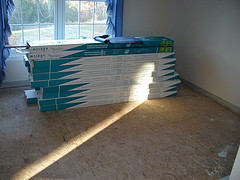6 Tips to Make Hardwood Floor Installation a Success
 Hardwood floors are always in fashion. It's no wonder -- they are both handsome and functional. What's more, long-lasting hardwood is uncomplicated to repair and has the kind of good looks that only improve with age. To get your hardwood floor installation off to the right start, follow these 6 tips.
Hardwood floors are always in fashion. It's no wonder -- they are both handsome and functional. What's more, long-lasting hardwood is uncomplicated to repair and has the kind of good looks that only improve with age. To get your hardwood floor installation off to the right start, follow these 6 tips.
1. Choose Where to Install Hardwood Flooring
Hardwood flooring brings a touch of coziness and class to your living room, dining room, bedroom, study, den, and man (or woman) cave.
Folks who are in love with the look of real wood may also want to put these floors in the kitchen or bathroom. While this is possible, it's tricky: the wood must be sealed around its perimeter and protected with a special finish that is highly water-resistant, but will also allow it to breathe.
Only install hardwood floors above grade -- that is, no more than 3 inches below the level of the ground to avoid an overly damp environment.
2. Know the Types of Wood Flooring Materials
Solid wood flooring is available as strips (the commonest kind, which comes in only 3 set widths but variable thicknesses), planks (in a variety of widths, but just 2 set thicknesses), and parquet (wooden slats are held together to form a geometric pattern).
It may be sold unfinished or prefinished. Look for a lifetime warranty. Because topnotch results require expertise to achieve, solid wood floors should be installed only by a reliable flooring contractor.
Engineered wood flooring (as opposed to laminate, which contains no real wood) comes in the form of planks, made from several thin sheets of wood which have been laminated together.
3. Choose an Installation Method
Compare hardwood floor installation methods based on the type of wood you will be using.
Nail down is suitable for installing solid wood, either strips or planks, onto a wood subfloor.
Staple down is similar to nail down, with the difference that it uses a pneumatic staple gun.
Glue down is the method of choice for parquet or engineered flooring.
Floating means the installation of wood flooring, usually of the engineered variety, "floating" on top of a layer of padding.
4. Pick the Best Time to Install
If you are building a new home or doing major remodeling, be sure to leave your hardwood floor installation until the construction is almost done. Processes such as plumbing or cement work, which involve the use of water, put the flooring at risk.
5. Prepare the Surface
Prepare a dry, flat surface on which to lay the floor -- raised plywood subflooring is the traditional method, but it could also be a fully cured, moisture-proofed slab of concrete if installation will be performed via the glue down or floating system.
The new wood flooring can also be installed on top of your current floor, although this does present 2 potential problems: a) the existing flooring must be level, clean, and structurally in good shape and b) this method raises the floor level somewhat so that it will not be even with flooring in adjacent rooms.
6. Prepare the Wood
Wood is a natural substance, which reacts to the environment in your home, especially the degree of humidity. The best seasons of the year for hardwood floor installation are spring and fall, when there is a moderate amount of moisture in the air but the climate is not overly damp.
Whenever you decide to have the floor installed, an indoor humidity level between 45-65 percent is recommended. Run the heating or air conditioning system as you normally would.
Make sure that your hardwood planks or sheets are delivered and are stored inside the house, with packaging opened, at least 4-5 days before you plan to have them installed. This will allow them time to acclimate to conditions in your home.
Laura Firszt writes for networx.com.
Looking for a Pro? Call us (866) 441-6648

Flooring Average Costs
Flooring Contractors Experiences

Incredible Hardwood Floor Restoration Helped Our House Sell Fast

How I Chose My Flooring Contractor And Why I’m Glad I Did



